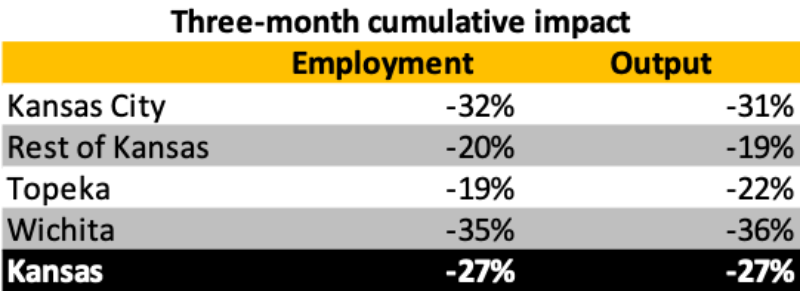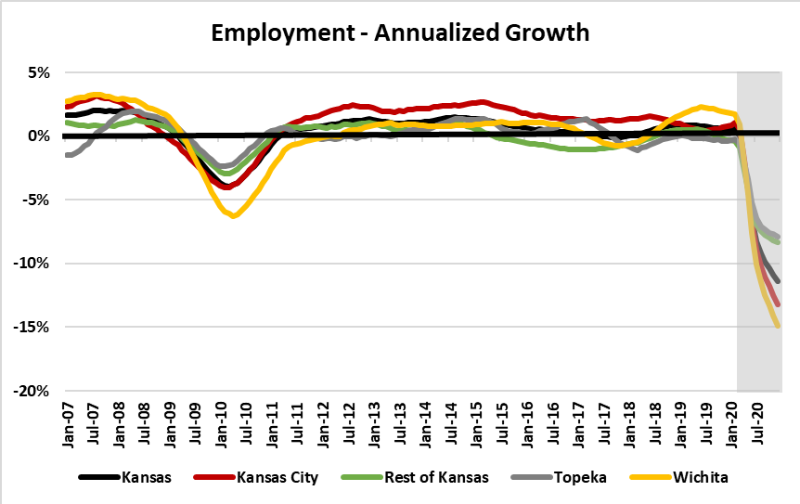The economic impact of COVID-19 on the Kansas economy had an immediate effect on the manual service sectors like full-service restaurants and entertainment. As the demand for those services came to an abrupt halt, those industries laid off workers.
According to Wichita State University’s Center for Economic Development and Business Research (CEDBR), the ripple effect of decreased demand along with public policies limiting activity continues to weigh down the economy.
The CEDBR, part of WSU’s W. Frank Barton School of Business, developed a model to estimate the economic ripple effects on Kansas’ three metropolitan areas, along with the rest of the state.
The impact analysis included decreased demand, supply chain issues, decreased productivity and increased purchases in select sectors like grocery stores.
The project also included the federal stimulus funding flowing into each region of the economy through households, governments and businesses. Because there is not a clear end date to the effects of the COVID-19, this analysis was limited to a three-month period.
Wichita will have largest percentage decrease in employment and output
The impact of the pandemic is expected to decrease both employment and output within the Kansas economy by 27% within three months.
The largest percentage decrease is expected to be in the Wichita metropolitan area, as the region had an already weak aerospace sector because of the 737 Max freeze and a higher concentration of vulnerable service sectors compared to the state.
The Kansas City, Kansas, metropolitan area is expected to have the second largest decline in economic activity. Although the durable manufacturing sector is expected to be impacted by the supply chain disruptions, the area’s concentration in the vulnerable service sectors puts the region at a higher risk of losing these types of jobs.

The 27% impact on employment accounts for a loss of just under 388,000 jobs across
the state, which includes both full-time and part-time jobs. The impact on labor income
for three months is expected to be $4.8 billion. Output measures all lost sales plus
or minus inventory, whereas value added more closely aligns with gross state product.
The multiplier for value added production lost due to the coronavirus is 1.9. That
means each dollar of economic activity lost, there is an additional .90 cents lost
within the supply chain and other household consumption.

Although the Wichita area is expected to have the largest percentage decline, the
Kansas City area is expected to have the largest decline in total number of jobs,
income and output. This region accounts for 40% of all jobs expected to be lost and
45% of labor income.
The rest of Kansas, which includes a number of micropolitan towns, is expected to lose over 103,000 jobs and about $1 billion in lost labor income over a three-month period. Topeka is expected to have the smallest loss with only 21,000 jobs and $217 million in labor income. The smaller concentration of the most vulnerable service sectors along with a higher concentration of government jobs both help insulate the economic impact.

The largest annualized decline in employment during the great recession was 4.6% in
October 2009. When annualizing the impact of the coronavirus, the loss is expected
to get to at least 12.1%, which is almost three times the previous employment loss.

Regional impact


Wichita State is distinctive for opening pathways to applied learning, applied research and career opportunities, alongside unsurpassed classroom, laboratory and online education. The university's beautiful 330-acre main campus is a supportive, rapidly expanding learn-work-live-play environment, where students gain knowledge and credentials to prepare for fulfilling lives and careers. Students enjoy a wide selection of day, evening and summer courses in more than 200 areas of study at the main campus and other locations throughout the metro area and online. WSU's approximately 16,000 students come from every state in the U.S. and more than 100 other countries. Wichita State's Innovation Campus is an interconnected community of partnership buildings, laboratories and mixed-use areas where students, faculty, staff, entrepreneurs and businesses have access to the university's vast resources and technology. For more information, follow us on Twitter at www.twitter.com/wichitastate and Facebook at www.facebook.com/wichita.state.

